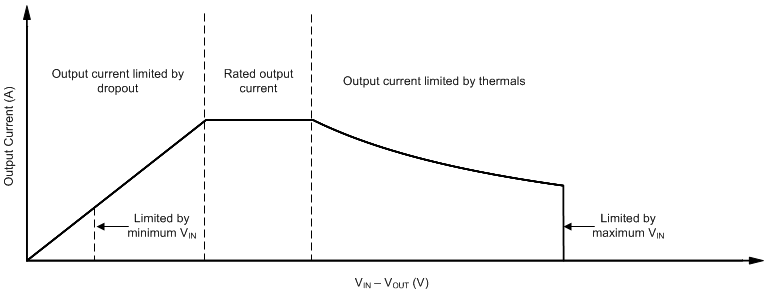SBVS398A December 2021 – September 2022 TPS7A21
PRODUCTION DATA
- 1 Features
- 2 Applications
- 3 Description
- 4 Revision History
- 5 Pin Configuration and Functions
- 6 Specifications
- 7 Detailed Description
- 8 Applications and Implementation
- 9 Device and Documentation Support
- 10Mechanical, Packaging, and Orderable Information
Package Options
Refer to the PDF data sheet for device specific package drawings
Mechanical Data (Package|Pins)
- YWD|4
Thermal pad, mechanical data (Package|Pins)
Orderable Information
8.1.7 Recommended Area For Continuous Operation
The operational area of an LDO is limited by the dropout voltage, output current, junction temperature, and input voltage. The recommended area for continuous operation for a linear regulator is given in Figure 8-3 and can be separated into the following parts:
- Dropout voltage limits the minimum differential voltage between the input and the output (VIN – VOUT) at a given output current level. See the Section 7.4.3 section for more details.
- The rated output currents limits the maximum recommended output current level. Exceeding this rating causes the device to fall out of specification.
- The rated junction temperature
limits the maximum junction temperature of the device. Exceeding this rating
causes the device to fall out of specification and reduces long-term
reliability.
- The shape of the slope is depicted in the third region of Figure 8-3. The slope is nonlinear because the maximum-rated junction temperature of the LDO is controlled by the power dissipation across the LDO. Thus, when VIN – VOUT increases the output current must decrease.
- The rated input voltage range governs both the minimum and maximum of VIN – VOUT.
Figure 8-3 shows the recommended area of operation for this device on a JEDEC-standard high-K board with a RθJA, as given in the Section 6.4 table.
 Figure 8-3 Region
Description of Continuous Operation Regime
Figure 8-3 Region
Description of Continuous Operation Regime